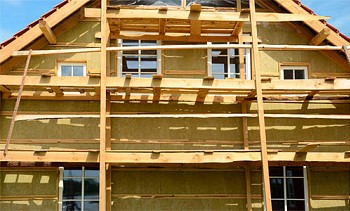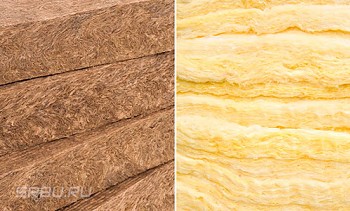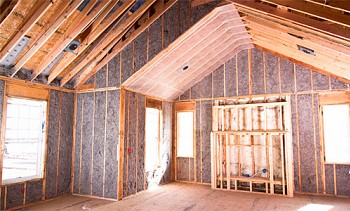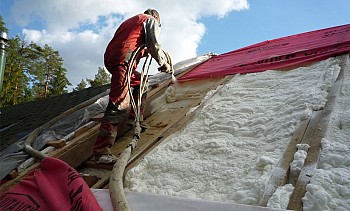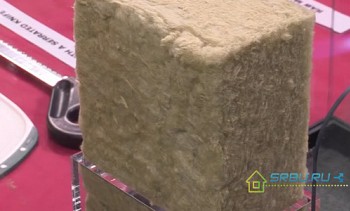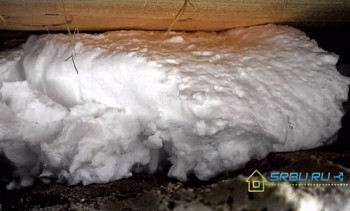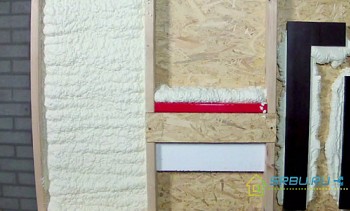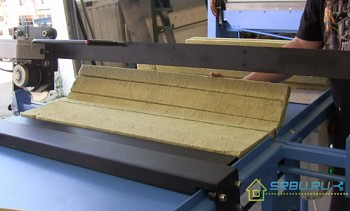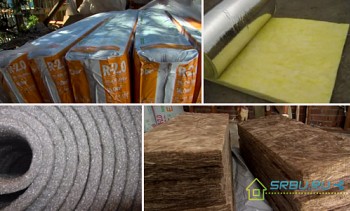Thermal insulation materials today produce so much that my eyes run up. Some of them serve for a long time, others - not very. They differ from each other in both technical parameters and structure. Common to most modern heaters is that they are made of artificial substances. Ecowool stands out against their background, the technical characteristics of which are determined by the natural origin of the material. It contains only fluffy cellulose fibers and natural antiseptics with flame retardants - in other words, wood and minerals. In addition, ecowool has not a porous structure, like other heat insulators, but capillary.
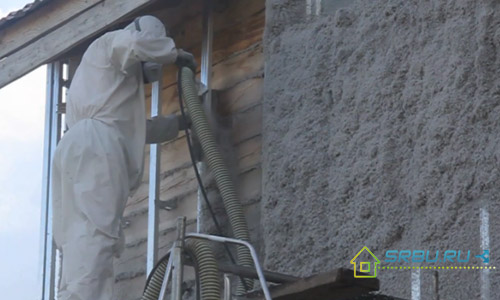
What is ecowool: source components and application
For the manufacture of ecowool several types of raw materials are used.
1. Waste paper and cardboard production. This, in particular, may be:
- Trimming in the manufacture of corrugated cardboard products.
- Marriage remaining after printing books and magazines.
- Cardboard raw material waste, as well as defective cardboard parts.
2. Old newspapers and magazines, books, paper, cardboard. Such raw materials are considered second-rate, as they are more polluted. In addition, the waste paper is very heterogeneous - it may include different types of paper.
Cellulose fibers made from recycled materials occupy 80 percent of the ecowool. Another 12 percent belongs to boric acid - a natural antiseptic. This substance is intended to protect the insulation from bacteria and fungi. The remaining 8 percent is the proportion of sodium tetraborate flame retardant. It not only increases the fire resistance of the material, but also adds insecticidal properties to it. When wetted, the ecowool fibers become sticky. This is due to the lignin contained in them.
As an ecowool insulation, it is used today quite often. It is used for thermal insulation of industrial premises, offices, warehouses, trade pavilions, as well as residential buildings. It is very practical to isolate with this material those rooms where the humidity is constantly high and there is a danger of condensation.
Ecowool insulation can be done in three ways:
1. Application by the dry method - used mainly in summer cottages. So the attic rooms, internal slopes of the roof, floors and walls with floor are insulated. For this purpose, equipment is used specifically that feeds the material through the hose and the master slowly puts it on the floor. If you need to fill the interior of the wall or sloping ceiling with a heater, then use the hose again, slowly filling up the existing recesses.

Dry ecowool application on the surface of the attic.
2. The wet method is used when in the future it is necessary to sheathe the insulated wall. In this case, water is added to the starting material. The mixture, drying, forms a fairly dense layer.

Wet application method. During operation, such a large amount of dust is not created.

Device for removing excess ecowool.
3. The glue method is used if it is necessary to insulate metal or reinforced concrete structures. For example, the ceilings and walls of hangars are insulated in this way. The adhesive properties of the adhesive mixture are very good, so the coating adheres well to the surface. It turns out to be durable; outside cladding is not required.
Ecowool: technical specifications
Material properties as a heat insulator
Ecowool keeps heat very well. This can be judged by the value of the coefficient of thermal conductivity - it ranges from 0.032 to 0.041 watts per meter per degree Celsius.In addition, due to the absence of seams, “cold bridges” do not appear on the coating. It is possible to fill with ecowool everything, even the smallest, cracks and voids, which compares it favorably with other heat insulators.
Any type of surface can be covered, covered or paved with this cellulose-based insulation. The monolithic ecowool coating, despite its low weight, has excellent heat-insulating properties. And this happens for the following reasons:
- The insulation consists of natural wood fibers.
- Fibers have a capillary structure, therefore they are able to hold air in themselves.
- Most of the volume of the material (from 85 to 92 percent) is occupied by the air gap, which perfectly retains heat.
- During isolation, all holes, seams and crevices are filled completely.
Noise protection
And here the ecowool characteristics are at their best. It absorbs extraneous sounds “with a bang” - this has been repeatedly tested experimentally. Here is an example: laying ecowool with just a ten-centimeter layer can reduce the noise level by 60 decibels.
As you know, sound waves propagate well through gaps, joints of walls, ceilings and floors, as well as cracks and voids. Since ecowool fibers are able to densely close up these same cracks, the sound when passing comes across an insurmountable barrier. Therefore, if there is a noisy establishment in a residential building on the ground floor, it is possible to use ecowool for armament. It will not let dashing music from a nightclub or karaoke bar interfere with the quiet sleep of the inhabitants of the house.
Video: Soundproofing Test
Environmental friendliness
Now much is said about the environment and the creation of materials that will not harm wildlife. Moreover, of course, they should not threaten human life and health.
As already mentioned, the foundation of ecowool is high-quality cellulose fibers, impregnated with antiseptic and fire-resistant substances. Of these substances - boric acid and borax - in it no more than 19 percent. Well, the remaining 81 percent is recycled newsprint, cardboard, book pages and other waste paper. By the way, glossy paper containing plastic is not suitable for ecowool production. This, for example, laminated book covers, as well as glossy paper with a wax or polyethylene top layer.
It should be noted that this raw material is clean - paper for the production of fibers does not contain harmful impurities, and additives in the form of a flame retardant and antiseptic are non-volatile. So we can conclude that this insulation is environmentally friendly. Neither during its installation, nor during operation of insulated buildings, there can be no danger to life and health.
Fire resistance
Flame retardants that increase the fire safety of ecowool are salts of boric acid. They do not allow the insulation to catch fire from an open flame - in a fire, ecowool not only does not burn, but does not even undergo melting. According to GOST 30244, it is assigned a combustibility group G2 (the so-called moderately combustible materials), and according to DIN 4102 - B1. If you remove the source of fire, then the insulation will go out on its own, without poisoning the air with poisonous gases.
The principle of operation of flame retardants is as follows: they allow you to organize the combustion process with a minimum of flammable substances. Only carbon that is harmless is released.
The composition of flame retardant additives is such that when heated, water is released that moistens the ecowool. It cools, and the fire cannot continue on its way without oxygen. So only slow decay occurs, which ceases when the temperature decreases. There are no toxic gases.
Video: Ecowool Fire Resistance
Density
During the production of ecowool, paper is made of very thin fibers, and the material turns out to be quite dense, able to hold air well. But it is precisely the stationary air gap that is one of the best heat insulators. The layer of insulation from ecowool can be more or less dense - it all depends on the method of its application.
- When warming the floors of lower floors, the density of the material varies from 35 to 42 kilograms per cubic meter.
- By warming inclined surfaces, a coating is obtained with a density of 45 to 55 kilograms per cubic meter.
- For vertical walls and partitions, the density of the insulation layer lies in the range from 55 to 65 kilograms per cubic meter.
- When applying ecowool using the wet method, a coating is obtained with a density of 65 to 75 kilograms per cubic meter.
Air permeability
Since the density of ecowool is high, and its fibers are thin, air passes through it poorly. Taking a heater of this type with a density of 35 to 42 kilograms per cubic meter, we get a breathability value of 75x10-6 cubic meters per meter per second on Pascal to 120x10-6 cubic meters per meter per second to Pascal.
Moisture resistant
Since cellulose fibers are made of wood, they can, like other wood materials, absorb water and then give it away. So we can say that this insulation “breathes” like a log or a beam.
Moreover, a change in air humidity in no way reduces the conservation of ecowool heat. After all, it can absorb water 5 or even 6 times more than it weighs itself. Therefore, not a drop of moisture does not get inside the house, and condensation does not appear.
When it gets dry outside, excess moisture (which can absorb up to 30 percent of the mass) easily leaves the insulation. After this, the ecowool properties remain the same. It should be noted that the humidity of this material, like that of wood, corresponds to the humidity of the air around. As for vapor permeability, its value lies in the range from 0.3 to 0.54 milligrams per meter per hour for Pascal.
Resistance to harmful substances and destructive factors
Speaking about the benefits of ecowool, it would not be out of place to mention that it perfectly protects a person from dangerous substances emitted by asbestos, fiberglass, polystyrene and other modern materials. Moreover, ecowool itself does not contain any harmful impurities, without isolating them during operation. Not only that - thanks to boron minerals, a metal covered with ecowool does not rust in a humid environment. Indeed, the pH of an aqueous solution of these minerals is 9, and after interaction with other components it becomes close to 8. This means that the alkaline component prevails, and metal corrosion does not occur. Minvata, by the way, does not give such an effect.
Life time
Over time, the properties of ecowool remain completely unchanged. Manufacturers determine her service life of at least a century. English, German and American experts have already proven this empirically. After all, cellulose fibers have been warming homes since ancient times. There are examples of buildings insulated with this material back in 1900. They stand to this day, perfectly keeping warm. As for domestic research, they can still talk about the fifteen-year life of this material.
Adhesive properties
Cellulose fibers, light and rough, adhere perfectly to any material.
But not everything is so good in the kingdom of ecowool and it, like other heaters that we considered earlier, has its drawbacks, to which we devoted a separate article:Ecowool - disadvantages and advantages of a heater.

